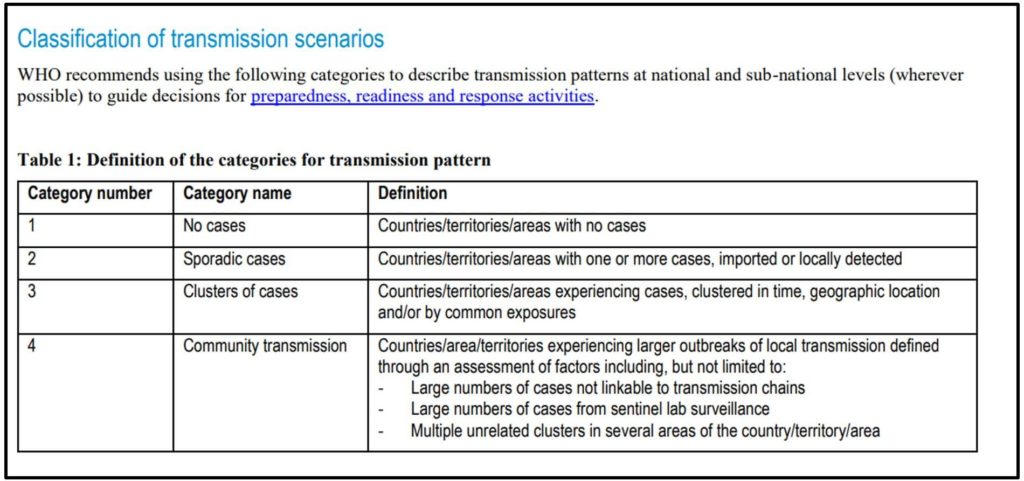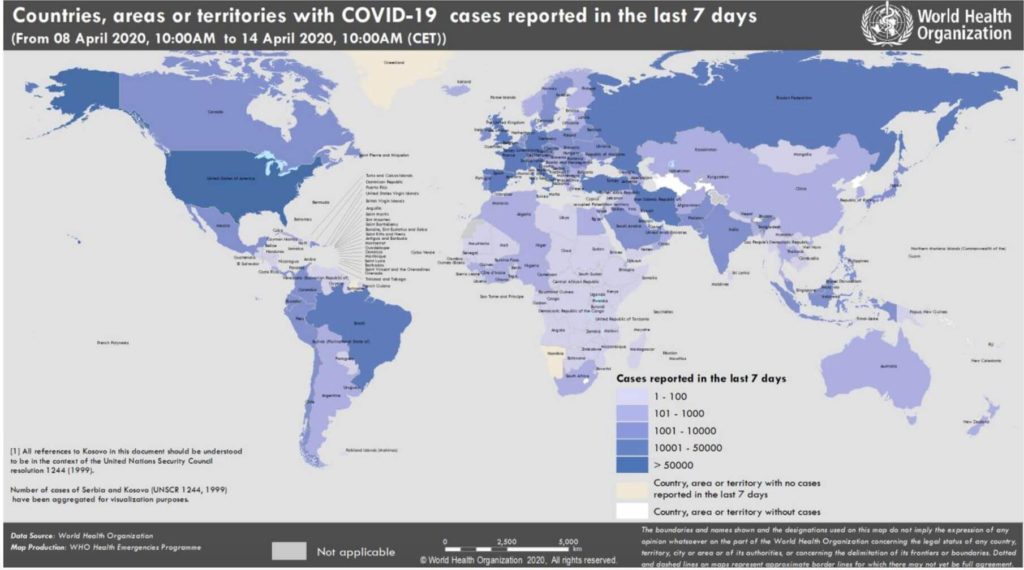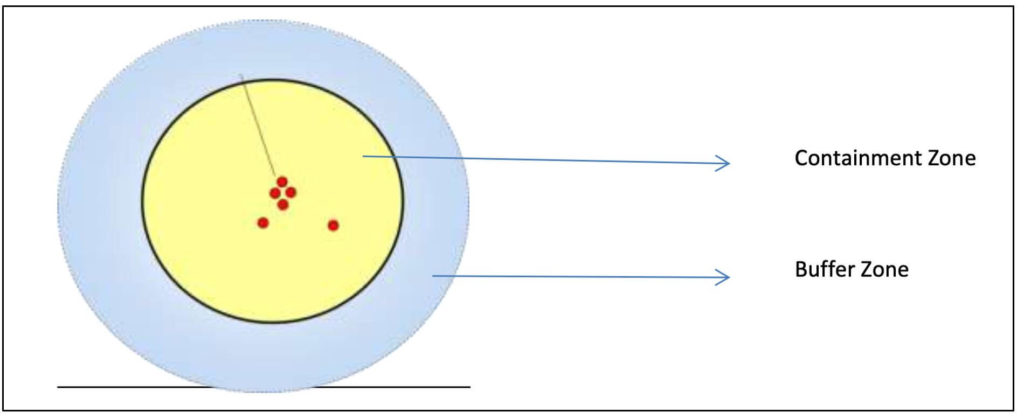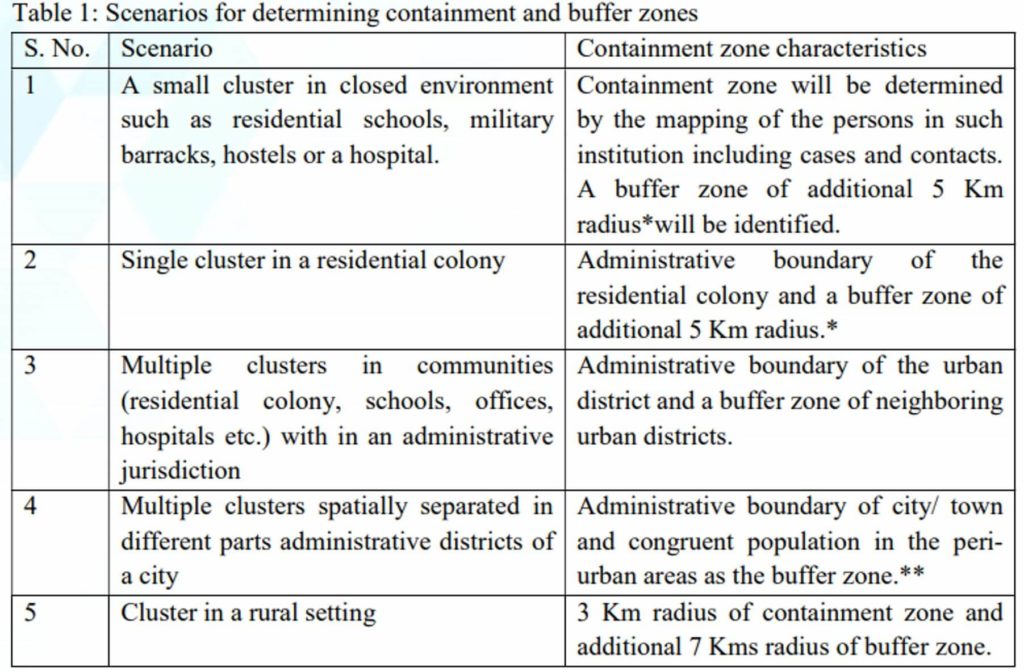As we enter the 2nd phase of a nation-wide lockdown, certain relaxations have been announced from 20 April outside the containment zones. What are these containment zones? What is the strategy of the government? Here is a detailed explainer.
Prime Minister Narendra Modi announced the extension of lockdown in the country till 03 May 2020 while addressing the nation for the fourth time amidst the COVID-19 outbreak. India has been under lockdown since 25 March 2020. While lockdown is aimed at containing the spread of virus & prevent community transmission, there are other containment measures taken by Central and State governments at the local level depending on levels of transmission & detection of positive cases in these areas. In his speech, the PM also added that from 20 April onwards, restrictions in some low-risk areas will be eased.
It is possible that one may have come across the term Stage-II transmission, community transmission, and other similar terms in news and social media. But what is community transmission? What are the different stages of transmission? Which stage is India currently in?
Ministry of Health has adopted a scenario-based approach for containing the virus
As per the containment plan of the Ministry of Health, India is following a scenario-based approach for containing the virus. These different possible scenarios, or the four stages of transmission are-
Stage I -Travel related cases reported in India
Stage II – Local transmission of COVID-19
Stage III – Large outbreaks amenable to containment
Stage IV – Wide-spread Community transmission
Stage V – India becomes an endemic for the disease.
As is evident, Stage I refers to travel related cases, meaning, those who have contacted the virus due to their travel to one of the centers/places of the outbreak. Local transmission or stage II is said to have taken place when the source of infection is within the reporting location. An example is contact with an infected person. At this stage, tracing all those persons who came in contact with the infected person, isolating and testing them will be helpful in containing the virus at this stage.
Community transmission is when the spread is such that source of virus cannot be traced as there are numerous cases in public. Stage V or India as an endemic is said to have taken place when the outbreak is so rampant that there is stark increase in number of infections and number of deaths and the disease is considered an endemic in the country.
WHO has defined four categories of transmission
Similarly, the World Health Organization has defined four different categories of transmission which is used at national and sub-national levels. These are
- No cases – When there are no cases within an area/ territory/ country.
- Sporadic cases – When one or more cases are imported or locally detected in an area/ territory/ country
- Clusters of cases – Cases in countries which are congregated in time, geographical location, or have had common exposure in an area/ territory/ country
- Community transmission – When there are large number of cases being reported but source of virus cannot be traced. That is, how the people contacted the virus cannot be identified since they have no travel history nor have had contact with someone, they know has COVID-19

Many countries in the Americas & Europe are at the stage of community transmission
WHO’s COVID Situation Report as on 14 April 2020, shows that countries like Turkey, Switzerland, Indonesia, Iran, Canada, Brazil, Ecuador, and more are at the Community Transmission Stage or the most affected stage. It can be observed that majority of the countries in the Region of Americas (North America and South America) are also at the community transmission level along with many European countries.
India falls under the category of ‘Clusters of cases’
Asian and Western Pacific Region have more countries falling in the ‘Clusters of Cases’ category. This includes China, South Korea, India, Sri Lanka, Myanmar, Pakistan, Saudi Arabia, Russia, Singapore, Australia among other countries. The data from some countries like UK, Germany, and Italy was pending.
New Zealand, Nepal, Bhutan, and some other countries are in the category of ‘sporadic cases’. Many countries in the African sub-continent fall under this category. No country falls under the ‘No cases’ category indicating the virus has spread to all countries.

As already seen, India falls in the category of ‘cluster of cases’. The Central Government has chalked out a cluster containment strategy to contain the virus and its spread in India as the number of cases is increasing.
What does a cluster mean?
According to Centers for Disease Control and Prevention, USA, a cluster is defined as ‘an unusual aggregation of health events that are grouped together in time and space and that are reported to a health agency.’ In simpler terms, a cluster means the occurrence of a disease in a geographical area at some period. This is reported to the health departments.
What is the cluster containment strategy?
Cluster containment strategy aims to contain the disease within the particular area through ‘early detection, breaking the chain and thus preventing its spread to new areas’.
For this, containment zones will be identified. The cluster will be considered the epicentre. Listing and mapping of contacts will be carried out by the local Rapid Response Team. Around the containment zone, a buffer zone of additional 5 kilometres radius is also set up. Buffer zone is where there is possibility for new cases to appear. Movement of people into and outside the zones will be highly regulated and vehicular movement is also restricted. All roads connecting the zones will be blocked and guarded by police.

Based on the size and area of cluster, the buffer zone can vary-

The area will be quarantined with boundaries set up. Only essential services are permitted in these zones. There will be continuous active surveillance in these areas. All suspected cases will be tested. Isolation of cases, home quarantine of contacts, and social distancing measures will be ensured. Testing for Influenza like Illnesses and Severe Acute Respiratory Syndrome (SARS) will also be carried out in such areas. Such a containment measure was earlier used in Rajasthan to contain the Zika Virus.
Districts to be categorized into three depending on cases reported
As a part of the containment strategy, in a high level review meeting held on 15 April 2020 held by the Cabinet Secretary with all the Chief Secretaries, Health Secretaries, DGPs, District Collectors, Municipal Commissioners, SPs, CMOs and other officials of States/UTs, the Central Government announced that each district in the country will be divided into one of the following categories–
- Hotspot districts – districts where more cases are being reported currently
- Non- Hotspot districts with reported cases – few cases are reported now
- Green zone districts – no fresh cases have been reported in some time
In addition to classification of districts, government has also asked districts to classify hospitals into COVID Care Centres for mild cases, COVID Health Centres for clinical moderate cases which require oxygen support, and COVID dedicated hospitals for severe and critical cases which require ventilator support.
Certain activities to resume depending on intensity of the disease & location
The Ministry of Home Affairs issued fresh guidelines on 15 April 2020 that included details on partial relaxation of lockdown from 20 April, as announced by the Prime Minister in his address. In this order, the government has announced that some economic activities can be resumed if proper social distancing is followed by the officials and employees. It has to be noted that such relaxations are only for areas in the non-containment zones.
Here are few important takeaways from the order:
Post April 20, based on intensity of outbreak in different areas, the following activities will be allowed:
- All agricultural and horticultural activities, fishing and aquaculture industry will be permitted provided social distancing is maintained
- Tea, coffee, and rubber plantations with only 50% workers. Same in the case of processing, packaging, sale, and marketing of these products
- Animal husbandry farms, dairy processing and transport, animal feed manufacturing
- RBI, RBI regulated financial markets and entities, bank branches, ATMs
- SEBI, IRDAI and other insurance companies
- MGNREGA works allowed provided social distancing measures are adhered to
- Irrigation and water conservation sectors
- Postal, telecommunication and internet service providers
In case of private and commercial establishments, the following are permitted
- Print and electronic media, DTH and cable service providers
- E- Commerce companies and courier services
- Data and call centres for government activities only
- IT and IT enabled services with up to 50% staff
- Private security services
The following will continue to be restricted:
- Domestic and international air travel, movement by trains, public transport including bus, metro, auto rikshaws and cabs will be suspended. Only transportation of essential goods and medical purposes allowed.
- Inter-district and inter-state movement is also restricted unless medical purpose is involved
- Educational institutions will continue to remain closed
- All forms of gathering – be it social, political, religious, etc. are banned
- Cinema halls, gymnasiums, malls, bars and auditoriums, halls, etc. will continue to remain shut
Featured Image: COVID-19 containment strategy


